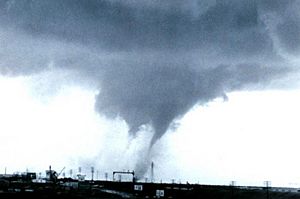Multiple-vortex tornado facts for kids


Imagine a tornado, but inside it, there are smaller, spinning mini-tornadoes! That's what a multiple-vortex tornado is. These smaller spins are called subvortices or suction vortices. They spin around inside the main tornado.
Sometimes, you can see these smaller vortices when a tornado is just starting. They can make the tornado's winds much stronger, adding over 100 miles per hour! This is why some parts of a tornado's path have extreme damage, while nearby areas have less.
Understanding Multiple-Vortex Tornadoes
What Are Suction Vortices?
Suction vortices are like tiny tornadoes within the main tornado. They are often found at the bottom of the tornado, where it touches the ground. These smaller spins are not always easy to see. They form because of how air moves into and up through the tornado.
Where Else Do We See Multiple Vortices?
Multiple vortices are not just found in tornadoes. You can also see them in other spinning air currents, like dust devils. This is a natural part of how spinning systems work in physics.
Multiple-Vortex Tornadoes vs. Tornado Families
It's important not to confuse multiple-vortex tornadoes with other types of tornado events. Sometimes, a very strong storm called a supercell can create many separate tornadoes. These are called tornado families. They can happen at the same time or one after another.
Multiple-Vortex Tornadoes vs. Satellite Tornadoes
Another similar event is a satellite tornado. A satellite tornado is different because it forms outside the main tornado. It also forms in a different way than the small vortices inside a multiple-vortex tornado.
Famous Multiple-Vortex Tornadoes
The Joplin Tornado (2011)
The very destructive Joplin, Missouri tornado in May 2011 was a multiple-vortex tornado. This tornado was rated as an EF5, which is the highest rating for tornado damage.
The El Reno Tornado (2013)
The largest tornado ever recorded was also a multiple-vortex tornado. It hit El Reno, Oklahoma, on May 31, 2013. This tornado was incredibly wide, measuring about 2.6 miles (4.2 kilometers) across.
It had recorded wind speeds of at least 302 miles per hour (486 kilometers per hour). Even with these extreme winds, it was rated EF3. This lower rating was because it didn't cause as much property damage in its path. Sadly, this storm took the lives of several people, including tornado researcher Tim Samaras.
Other Powerful Tornadoes
The El Reno tornado is one of the two strongest tornadoes ever recorded by wind speed. The other was the 1999 Bridge Creek–Moore tornado. That tornado had winds measured at 318 miles per hour (512 kilometers per hour). The 1997 Jarrell Tornado was also a multiple-vortex tornado. A famous photo of it, called "Dead Man Walking," showed its early subvortex development.
See also

